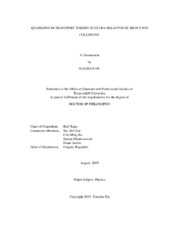| dc.description.abstract | The study of the fundamental strong interaction is an important vehicle for advancing our understanding of nuclear physics. Quarkonia, bound states of heavy quark-antiquark pairs, are promising probes for studying the strong force, in particular its confining property which constrains quarks and gluons to hadrons. Ultrarelativistic heavy-ion collisions (URHICs) are the only experimental method that can screen the strong force by creating a hot and dense medium. The suppression of quarkonia observed in URHICs is believed to be due to the formation of a deconfined quark-gluon plasma (QGP), a medium with unbound quarks and gluons. In order to study this phenomenon, we utilize a transport model to describe the evolution of quarkonium states in URHICs. This model calculates the suppression of heavy quarkonia, as well as recombination of heavy quark-antiquark pairs, in the medium. For charmonium, in particular, the recombination is essential for describing the momentum and energy dependencies of their spectra. Based on the fact that different binding energies lead to different dissociation temperatures, a “sequential regeneration” of excited and ground-state charmonia is proposed and implemented to compare to experimental data in nuclear collisions. Charmonium production in proton/deuteron-ion (p/d-A) collisions is also calculated with an extension of the transport model. The extension has a new background medium for p/d-A and more complete hadronic dissociation rates including many more mesons interacting with charmonia.
This is particularly important at the Relativistic Heavy-Ion Collider (RHIC) energy because of the dominance of the hadronic contribution. The calculation suggests a QGP formation even in a small collision system such as p-Pb collisions at the Large Hadron Collider (LHC). The same transport model is deployed to study bottomonium kinetics, providing a comprehensive framework for both charm and bottom bound states. A stronger suppression for excited bottomonium states is found compared to the ground state. Furthermore, bottomonium is particularly sensitive to the in-medium strong force, as recombination is found to be at a much smaller level than for charmonium. This enables us to implement the transport model into a statistical analysis to constrain, for the first time, the in-medium properties of the underlying potential via transport parameters in χ 2 fits to experimental data. A rather strong in-medium heavy quark-antiquark potential is extracted, indicating the quark-gluon plasma to be a strongly coupled medium. | en |


